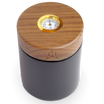Table of Contents
- Introduction
- What Are Terpenes?
- Why Terpenes Matter in Cannabis
- The Entourage Effect: Terpenes + Cannabinoids
- Major Cannabis Terpenes and Their Effects
- Health Benefits Beyond Cannabis
- Why Vaporization Preserves Terpenes
- How to Read Terpene Lab Results
- Choosing the Right Terpenes for Your Goals
- Conclusion
- About the Author
Introduction
When most people think about cannabis, they focus on THC and CBD. But there’s a whole world of compounds that shape your experience—and at the top of that list are terpenes. These aromatic molecules are responsible for the distinct smell and flavor of each strain—but more importantly, they affect how cannabis feels in your body and mind.
Whether you're looking for clarity, calm, focus, or deep relaxation, terpenes help guide the experience. In fact, many users now choose strains not by THC percentage, but by terpene profile.
This guide will help you understand what terpenes are, how they work, and how to use them to customize your cannabis experience. From the citrusy brightness of limonene to the sedative calm of myrcene, you’ll learn how to select terpene-rich strains and why low-temp vaporization is the best way to preserve their benefits.
What Are Terpenes?
Terpenes are aromatic compounds found in many plants, including cannabis, that give them their distinctive smell and flavor. They’re responsible for the citrus scent of lemons, the piney sharpness of rosemary, the floral note in lavender, and the pungent skunkiness in some cannabis strains.
In nature, terpenes serve multiple functions: they help plants repel predators, attract pollinators, and protect against pathogens. In cannabis, they do all of that—and more. Terpenes interact with your body and brain in powerful ways, influencing mood, alertness, stress, and inflammation.
Cannabis produces over 150 known terpenes, although only a handful appear in high concentrations. These top terpenes shape the effects and character of each strain.
Why Terpenes Matter in Cannabis
Terpenes don’t just smell good—they modulate the effects of cannabinoids like THC and CBD. Depending on the terpene profile, the same amount of THC can feel energizing, calming, uplifting, or deeply sedating.
Example:
- A 20% THC strain rich in limonene may feel bright, euphoric, and social
- The same THC level with high myrcene might make you sleepy or deeply relaxed
This is why two strains with identical THC content can deliver completely different effects. Terpenes are the “steering wheel” of your cannabis experience—guiding the direction and tone of each session.
Understanding terpene profiles is key to intentional cannabis use. It allows you to tailor effects to your needs—whether that’s productivity, sleep, anxiety relief, or creativity.
The Entourage Effect: Terpenes + Cannabinoids
One of the most important reasons to care about terpenes is the entourage effect—a term used to describe how cannabinoids and terpenes work synergistically in the body. Instead of acting alone, compounds in cannabis enhance or balance one another’s effects when consumed together.
For example:
- Myrcene may enhance THC’s ability to cross the blood-brain barrier, increasing its sedative qualities
- Linalool (also found in lavender) can temper THC’s intensity and promote calm, making it useful for anxiety relief
- Pinene may help counteract THC-induced memory fog or disorientation
This synergy helps explain why full-spectrum cannabis extracts often outperform isolated THC or CBD. When terpenes are preserved and paired with their native cannabinoids, the overall therapeutic and psychoactive effects become more nuanced, personalized, and effective.
Major Cannabis Terpenes and Their Effects
Below is a breakdown of the most common terpenes found in cannabis, their aromas, and typical effects:
1. Myrcene
- Aroma: Earthy, musky, clove-like
- Effects: Sedating, muscle relaxant, may amplify THC effects
- Also found in: Mango, thyme, hops
2. Limonene
- Aroma: Citrus, lemon, orange peel
- Effects: Uplifting, anti-anxiety, mood boosting
- Also found in: Citrus fruit rinds, peppermint
3. Pinene
- Aroma: Pine, forest, rosemary
- Effects: Alertness, memory retention, anti-inflammatory
- Also found in: Pine needles, basil, parsley
4. Linalool
- Aroma: Floral, lavender, sweet
- Effects: Relaxing, calming, useful for sleep and stress
- Also found in: Lavender, coriander
5. Caryophyllene
- Aroma: Spicy, peppery, woody
- Effects: Anti-inflammatory, pain-relieving, interacts directly with CB2 receptors
- Also found in: Black pepper, cinnamon, cloves
6. Terpinolene
- Aroma: Sweet, herbaceous, apple-like
- Effects: Mildly uplifting, antioxidant, less studied but common in Sativa strains
- Also found in: Nutmeg, cumin, lilacs
Each terpene can express differently based on dosage, strain interaction, and personal biology. Keep an open mind—and a curious nose—as you explore.
Health Benefits Beyond Cannabis
Terpenes aren’t just important in cannabis—they’ve been used therapeutically for centuries in herbal medicine, aromatherapy, and natural wellness. Many terpenes are classified as bioactive compounds, meaning they have measurable effects on the body and mind even outside of cannabis.
Well-Studied Therapeutic Properties:
- Anti-inflammatory: Caryophyllene, pinene, and myrcene have all shown potential in reducing inflammation
- Anxiolytic (anti-anxiety): Limonene and linalool are both used to reduce stress and promote calm
- Neuroprotective: Terpenes may help protect brain cells from oxidative stress and support cognitive function
- Antibacterial & antifungal: Some terpenes like eucalyptol and terpinolene possess antimicrobial properties
These effects are the reason essential oils have long been used in holistic medicine. Terpenes are the shared language between aromatherapy and cannabis science.
By understanding terpene function beyond cannabis, users can choose strains that align with broader health goals—whether that’s improved sleep, reduced pain, or better focus.
Why Vaporization Preserves Terpenes
Unlike smoking, which combusts plant material at high temperatures (~600°C), vaporization gently heats cannabis at lower, controlled temps (usually 150–230°C). This makes it the ideal method for preserving volatile compounds like terpenes.
Why Terpenes Need Careful Heating:
- Each terpene has a unique boiling point (e.g., myrcene: ~166°C, limonene: ~176°C)
- Too much heat = burnt taste + lost aroma + reduced therapeutic effect
- Lower temp vapor = richer flavor, better control, and smoother inhale
Devices like the Vapman and Lotus give you precision over heat and breath—so you can explore terpene-rich vapor sessions without combustion or flavor loss. This makes them ideal for those prioritizing plant integrity, clean inhalation, and full-sensory experience.
How to Read Terpene Lab Results
Many dispensaries and cannabis brands now include terpene profiles on lab reports (Certificates of Analysis or COAs). Learning how to read these helps you make better-informed decisions based on your desired effects, rather than just chasing THC percentage.
Look for These Indicators:
- Total Terpene Content: Expressed as a percentage (e.g., 1.8% total terpenes)
- Top 3 Terpenes: Typically listed by weight—e.g., limonene 0.7%, myrcene 0.4%, caryophyllene 0.2%
- Ratio matters: Even small amounts of certain terpenes can tip the effect profile
For example, if a strain lists dominant myrcene and linalool, it’s likely more relaxing. If it features limonene and pinene, expect more energy and mental clarity.
Don’t be afraid to ask for lab reports at dispensaries. And if shopping online, only purchase from companies that share verified terpene and cannabinoid data.
Choosing the Right Terpenes for Your Goals
Choosing a strain by terpene profile is more reliable than by name alone (e.g., "Blue Dream" can vary wildly by grower). Here’s a basic guide to align terpenes with your desired effects:
For Focus and Energy:
- Terpenes: Limonene, pinene, terpinolene
- Use with: Low doses, vaporized at ~170–180°C
- Good for: Daytime productivity, creative work, social energy
For Relaxation and Sleep:
- Terpenes: Myrcene, linalool, caryophyllene
- Use with: Evening ritual, slightly higher temp (~190–210°C)
- Good for: Insomnia, stress, muscle tension, winding down
For Balanced Mood and Stress Relief:
- Terpenes: Limonene, linalool, beta-caryophyllene
- Use with: Gentle vapor sessions or microdoses throughout the day
- Good for: Anxiety management, emotional clarity, mood regulation
Combining terpene knowledge with thoughtful vaporization (like with the Vapman or Lotus) gives you greater control over your cannabis experience—helping you match the moment with precision and mindfulness.
Conclusion
Terpenes are the unsung heroes of cannabis. They shape how your flower smells, how it tastes—and most importantly—how it feels. By learning to identify and understand these aromatic compounds, you unlock a new level of precision and personalization in your cannabis experience.
Whether you’re chasing energy, calm, creativity, or relief, the right terpene profile can guide your session in the right direction. And when combined with gentle, temperature-controlled vaporization using tools like the Vapman or Lotus, you preserve those delicate molecules for full therapeutic benefit.
From lab reports to lived experience, terpenes are the compass that helps you inhale with intention. Explore them. Respect them. And let your nose—and your nervous system—lead the way.
About the Author

Author: Michael Mussner, Founder of INHALE Vaporizers
Michael is a passionate vaporizer designer and entrepreneur from South Tyrol, driven by craftsmanship, sustainability, and the mindful use of natural herbs. With a background in product innovation and a love for analog technology, he founded INHALE to revive flame-powered vaporizers like the Vapman and Lotus. Every product he creates is deeply rooted in authenticity, simplicity, and a respect for nature.
Questions? Contact us here or email support@nowinhale.com.

















Leave a comment
All comments are moderated before being published.
This site is protected by hCaptcha and the hCaptcha Privacy Policy and Terms of Service apply.